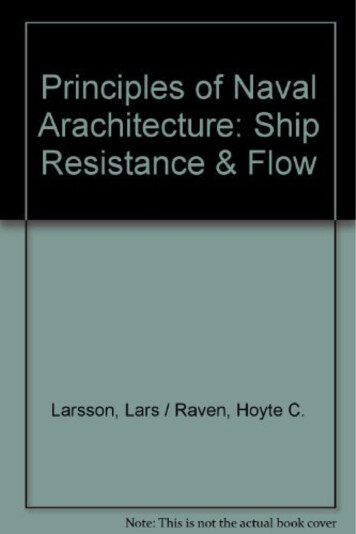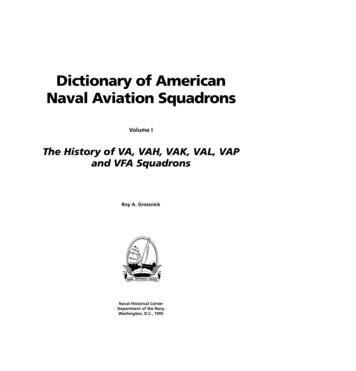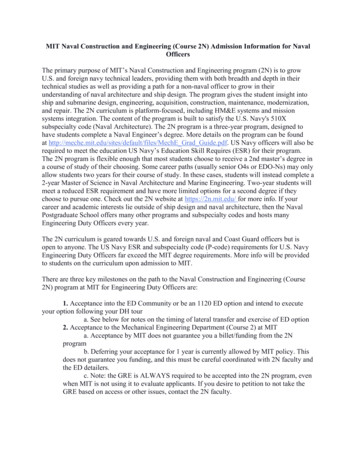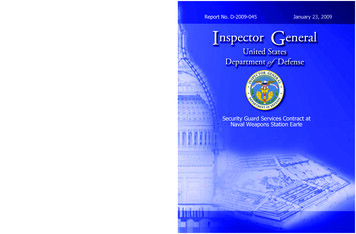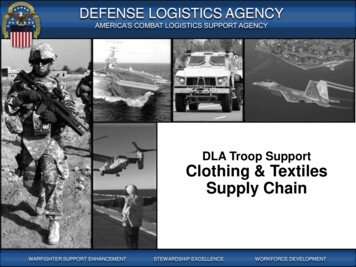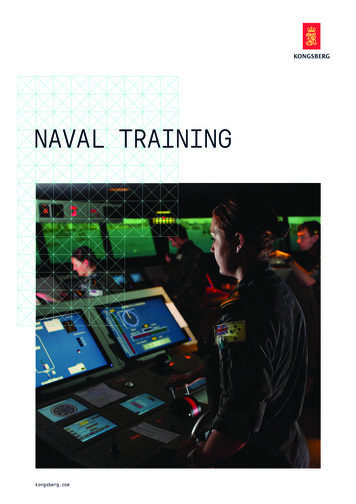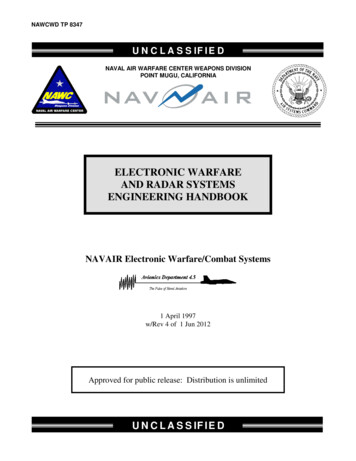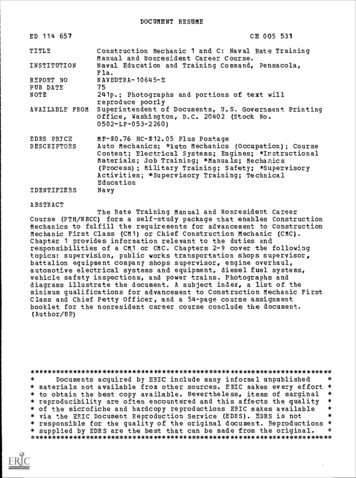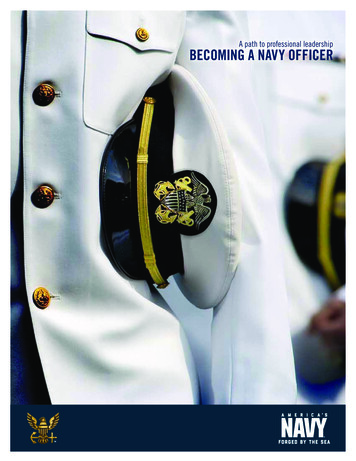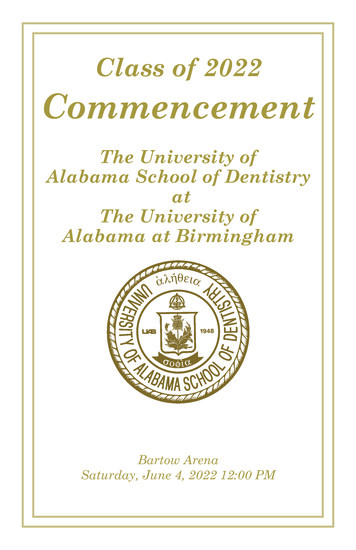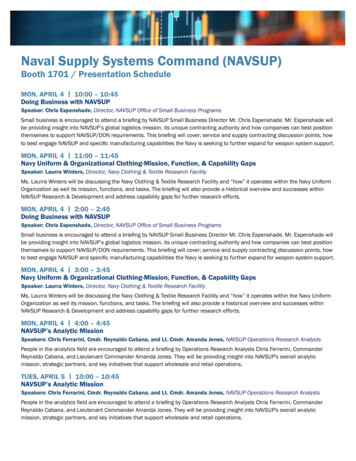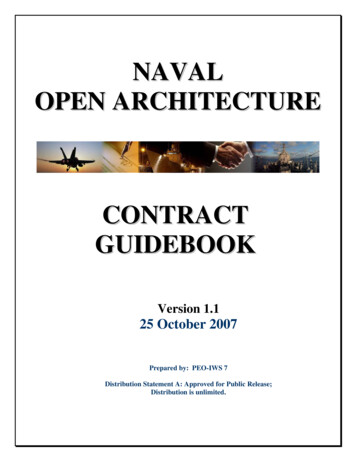
Transcription
NAVALOPEN ARCHITECTURECONTRACTGUIDEBOOKVersion 1.125 October 2007Prepared by: PEO-IWS 7Distribution Statement A: Approved for Public Release;Distribution is unlimited.
Table of ContentsINTRODUCTION. 1Chapter A: RECOMMENDATIONS FOR SECTION C LANGUAGE. 10Chapter B: EXAMPLES OF SECTION H LANGUAGE . 17Chapter C: RECOMMENDATIONS FOR SECTION L LANGUAGE . 28Chapter D: RECOMMENDATIONS FOR SECTION M LANGUAGE. 46Chapter E: RECOMMENDATIONS FOR INCENTIVIZING CONTRACTORS 49Appendix 1: RECOMMENDED NOA CDRL AND DELIVERABLE ITEMS. 1-1Appendix 2: 23 DEC 05 OPNAV REQUIREMENT LETTER . 2-1Appendix 3: NOA CHECKLIST (short) . 3-1Appendix 4: NOA CHECKLIST (long). 4-1Appendix 5: PEER REVIEWS, ADVANCED CAPABILITY BUILD PROCESSAND OA “INS AND OUTS”. 5-1Appendix 6: RECOMMENDED DATA LANGUAGE FOR CODE HEADERS. 6-1Appendix 7: RECOMMENDATIONS FOR SYSTEM SPECIFICATIONLANGUAGE . 7-1Appendix 8: OPEN SOURCE SOFTWARE (OSS). 8-1Appendix 9: DOD INFORMATION TECHNOLOGY STANDARDS ANDPROFILE REGISTRY (DISR). 9-1Appendix 10: GLOSSARY OF TERMS. 10-1Appendix 11: FEEDBACK FORM . 11-1
Distribution Statement A – Approved for Public Release;Distribution is unlimited.NOA Contract Guidebook v1.1October 25, 2007INTRODUCTIONPurpose: The Naval Open Architecture Contract Guidebook is recommended forProgram Managers (PMs) who are incorporating Naval Open Architecture (NOA)principles into National Security System (NSS) acquisition programs as defined by 40U.S.C § 11101 et seq. These same principles, described later in this document, can betailored to apply to the acquisition of any system, including those not considered to be“information intensive.”This Guidebook contains only recommendations and is offered with the understandingthat individual Program Executive Offices (PEOs) and programs must have the flexibilityto adapt its principles and guidance to meet their needs. This document is intended toaugment, rather than replace, existing contractual source materials such as the FederalAcquisition Regulations (FAR), the Defense Federal Acquisition Regulation Supplement(DFARS). Readers are also advised to review Assistant Secretary of the Navy (Research,Development and Acquisition)’s Memorandum on "Software Process ImprovementInitiative Contract Language," dated November 17, 2006, for additional information onNavy's basic software process improvement focus. The Memo provides guidance onlanguage to be used in a Request for Proposal (RFP) to “provide confidence to the Navythat software integrator and development contractors for Naval software systems havewell-documented, standardized software processes as well as continuous software processimprovement practices, equivalent to that articulated by Capability Maturity ModelIntegration (CMMI ) capability level 3. Further, this Memo directs that the languagecontained therein be included in all contracts that contain software development,acquisition, and life cycle support beginning with Request for Proposals (RFPs) issuedafter January 1, 2007. This version of the Naval Open Architecture Contract Guidebookcontains this language.There are a variety of tools, devices and resources available to the PM when planning forand conducting the acquisition of a NSS or other system using NOA guidelines such asthose contained in this Guidebook. The proper use of these resources is an importantelement of the acquisition process and will reduce the overall risk to the Navy byensuring that all necessary NOA aspects of the procurement are covered. In addition tothe contract and the Request for Proposal (RFP) and the Statement of Work (SOW)elements that are discussed in this Guidebook, the System Specification and other systemarchitecture and design materials are important. Because the System Specificationdefines the attributes of the overall system to be developed, it must describe how thetechnical system characteristics will contribute to its openness (such as its modularity andhow open standards will be incorporated). The System Specifications should alsoaddress those areas where future growth is expected, where reuse is envisioned, etc.Proper balancing and coordination among these elements is important to both thetechnical design and the overall lifecycle support of the system. Additional informationon these topics is included in the appendices of this document.1
Distribution Statement A – Approved for Public Release;Distribution is unlimited.NOA Contract Guidebook v1.1October 25, 2007Organization: This document is divided into five chapters containing suggestedlanguage for Sections C, H, L and M, and Award Fee Plans, respectively, of acquisitiondocuments; this material can be tailored for use in the specific phase of the acquisitionprogram. It can also be tailored for use in Contract Modifications. Appendix 1 containssuggested NOA-related items for use in preparing the Contract Data Requirements List(CDRL) and for identifying other contractual deliverables. Appendix 2 includesguidelines for conducting an analysis of a program’s intellectual property rightsrequirements. Appendix 3 provides an overview of the Small Business InnovativeResearch (SBIR) program and implications for NOA. Appendix 4 contains the 23December 2005 OPNAV Requirements letter that provides Sponsor’s guidance on NOA.Appendices 5 and 6 are Checklists that can assist the Program Manager to betterunderstand the business and technical aspects of NOA. Appendices 7 through 12 addressa range of topics related to NOA including Peer Reviews, Data Markings,Recommendations for System Specifications and Acquisition Plans, Open SourceSoftware, and the DoD Information Technology Standards and Profile Registry (DISR).Appendix 13 contains a Glossary of Terms.Providing Comments and Feedback: Development and maintenance of this Guidebookis a spiral process involving a series of “build-test-build” iterations, each on a roughlyannual release. These releases will incorporate community inputs and address topics thatemerge from the Naval Enterprise’s experience in NOA. Therefore, PEO IWS 7 is veryinterested in your comments, suggestions, and feedback and has included a FeedbackForm in Appendix 14. We are also very interested in any “real world” experiences youmay have in using NOA principles in programs. Comments can be submitted by mailusing the form provided in this document (as Appendix 14) or (preferred) bydownloading and submitting the electronic version found in the Policy and Guidancesection of the Naval OA Special Interest Area at the Acquisition Community Connection(https://acc.dau.mil/oa). Freeform emails with “Comments on NOA ContractGuidebook” in the subject line can also be sent to NavalOA@navy.mil.Background: Naval Open Architecture (NOA) is the confluence of business andtechnical practices yielding modular, interoperable systems that adhere to open standardswith published interfaces. This approach significantly increases opportunities forinnovation and competition, enables re-use of components, facilitates rapid technologyinsertion, and reduces maintenance constraints. NOA delivers increased warfightingcapabilities in a shorter time at reduced cost. The U.S. Government’s (hereinafter“Government”) ability to acquire at least Government Purpose Rights (GPR) to data andintellectual property and to minimize proprietary elements to the lowest component levelis critical to this effort.The Navy and Marine Corps have adopted OA as a way to reduce the rising cost of Navalwarfare systems and platforms and to increase the capabilities of our systems. NOAallows for incorporating more commercial-off-the-shelf (COTS) technology in warfaresystems and enabling re-use of software and related assets. In addition, NOA is anenabler of FORCEnet, the operational construct and architectural framework for Naval2
Distribution Statement A – Approved for Public Release;Distribution is unlimited.NOA Contract Guidebook v1.1October 25, 2007Warfare in the information age. More importantly, OA will contribute to greatercompetition among system developers through the use of open standards and standard,published interfaces. It will also require greater collaboration. Individual Domains (Air,Submarines, Surface, C4I, Space and Marine Corps) and PEOs may opt to pursuecommon architectures across their platforms or capabilities; the NOA principleshighlighted in these materials would apply to these common architectures.On June 5, 2007, the Department of the Navy (DON) Chief Information Officer (CIO)directed DON commands to treat Open Source Software (OSS) as COTS when it meetsthe definition of a commercial item (see the definition in the Glossary). This will allowthe DON to utilize OSS throughout the enterprise when acquiring capabilities to meetDON business and warfighter requirements. As with any COTS solution, the use of OSSmust adhere to all Federal, DoD, and DON policies and be based on open standards tosupport the DoD's goals of net-centricity and interoperability. In addition, DONcommands must work with their intellectual property general counsel to ensurecompliance with the OSS license agreement. 1This contract language guidance is designed to assist PEOs, Program Managers, legal,and contracting officials in addressing the technical and business aspects of OA in thesolicitation and award of Navy contracts. The language represents a long-term view andincorporates many of the principles of open systems mandated by the Department ofDefense (DoD) Open Systems Joint Task Force (OSJTF) and the Office of the Secretaryof Defense (OSD)/Networks & Information Integration (NII).Discussion: This Guidebook contains recommended language for Section C andassociated CDRLs of contracts and Sections L and M of solicitations issued by the Navyor Marine Corps for NSS or larger “system of systems” that integrate NSS with platformssuch as aircraft, submarines, land vehicles or ships. There are also recommendations forlanguage that can be incorporated in Section H of solicitations, including those that aredirected at existing programs. The term “NSS” refers to any telecommunications orinformation system operated by the United States Government, the function, operation, oruse of which (1) involves intelligence activities; (2) involves cryptologic activities relatedto national security; (3) involves command and control of military forces; (4) involvesequipment that is an integral part of a weapon or weapons system; or (5) is critical to thedirect fulfillment of military or intelligence missions, but excluding any system that is tobe used for administrative and business application purposes (including payroll, finance,logistics, and personnel management applications). 2Sections L and M are pre-award documents not incorporated into the actual contract butare key to ensuring Contractor understanding of and compliance with OA principles.Execution of an effective NOA strategy and/or asset reuse strategy must be consideredfrom both a Pre-Award and Post-Award perspective. The language contained in this1DoN Chief Information Officer, Memorandum for Distribution Department of the NavyOpen Source Software Guidance dated June 5, 2007.240 U.S.C. § 111033
Distribution Statement A – Approved for Public Release;Distribution is unlimited.NOA Contract Guidebook v1.1October 25, 2007document should be tailored to reflect the program’s phase and the goals of the intendedprocurement action.Program Managers are advised to use this recommended language and other appropriatetechnical documents after determining their relevance to the requirement of the specificacquisition being supported. Prior to tailoring this language to the specific needs of theacquisition program, Program Managers should have a clear understanding of NOAprinciples. Acquisition Programs should have a strategy and supporting plan thataddresses an appropriate (business and technical) OA end state and acts as a frameworkfor structuring contract language. The Open Architecture Assessment Tool (OAAT) 3(developed by the Naval Open Architecture Enterprise Team) and the Under Secretary ofDefense for Acquisition, Technology and Logistics (USD(AT&L)) Open Systems JointTask Force’s (OSJTF’s) MOSA PART 4 are two tools that may help to formulate a goodOA strategy. Appendices 5 and 6 consist of two checklists that will also be helpful inpreparing acquisition materials.The goal of maximizing program flexibility to enable competition and programmaticcourse changes must be balanced against providing the contractor enough incentive toagree to the contract. Short duration tasks and small deliverable quantities provide theProgram Manager with the flexibility to shift to other providers to obtain betterperformance, introduce different products and technologies, or when otherwise deemed inthe best interest of the Government. Such mechanisms are not a substitute for effectiveproject and contract management practices by the Program, but can provide additionalleverage to support these practices.Intellectual Property Rights (IPR) and Data Rights: Program Managers are stronglyencouraged to assess the IPR, in particular data rights, requirements of their programand/or community of interest. 5 General guidance for performing an assessment of IPRand Data Rights is contained in Appendix 2 of this document. This analysis will helpProgram Managers develop Acquisition Strategies that anticipate potential re-use in otherprograms and thus guide decisions related to IPR and data rights. These decisionsinclude: (1) whether these rights will be procured, (2) whether it will be considered aspart of the technical evaluation, and/or (3) a combination of both. The alternativeselected by the Program Manager will drive different solutions in the construct ofSections C, L and M. The attached Section L and M language provides general guidanceon data rights. Additional details would have to be worked with their specific programoffice.Program Managers (in coordination with their PEOs and Resource Sponsor) shoulddevelop a post-award strategy to ensure they are exercising their IPR as defined by the3The OAAT can be found on the Naval OA website at https://acc.dau.mil/oa.MOSA PART (Modular Open System Approach Program Assessment Review Tool).5A “community of interest” or COI is a group of organizations or entities having similarinterests and goals. For example, Navy COIs can be along warfare requirements (anti-airwarfare or littoral defense), families of system or components (radars or displays), orfunctions (acquisition or test and evaluation).44
Distribution Statement A – Approved for Public Release;Distribution is unlimited.NOA Contract Guidebook v1.1October 25, 2007Federal Acquisition Regulations (FAR) and Defense Federal Acquisition RegulationSupplement (DFARS). Historically, the Navy and Marine Corps have beendisadvantaged by not enforcing data rights identified by contractors in their proposalsand/or not including an effective Contract Data Requirements List (CDRL) and DataInformation Description (DID) into contracts. The Statement of Work (SOW) tells thecontractor how he is expected to develop the product/system; the CDRL orders thedelivery of the data according to the SOW, and the DID describes the format and contentof the data ordered by the CDRL. These procedures are articulated in the FAR andDFARS. It is incumbent upon the Government, in general, and the Program Managerand Contracting Officer’s Representative (COR) specifically, to review each deliverableand report unjustified/nonconforming or other inappropriate markings on delivered datato the Contracting Officer in order to ensure the PEO is able to take full advantage of theGovernment’s rights. The Contracting Officer, with the assistance of Counsel, isresponsible for enforcement of the DFARS provisions.An overarching concern is reconciling 10 U.S.C. § 2320 section (a)(2)(F) “Rights inTechnical Data” requirements with the proposed evaluation factors. Although theGovernment cannot condition award or responsiveness on relinquishing rights, under 10U.S.C. § 2320(a)(2)(G)(i) and (iii), the Government can negotiate for additional rights or,if necessary, the development of alternative sources of supply and manufacture. Also,under DFARS 227.7103-2(b)(2) “Acquisition of Technical Data” and DFARS 227.72032(b)(2) “Acquisition of Noncommercial Computer Software and Computer SoftwareDocumentation” the Government can and must balance the original assessment of theGovernment's data needs with data prices contained in the offer. Furthermore, 10 U.S.C.§ 2305(d)(4)(B) “Contracts: Planning, Solicitation, Evaluation, and Award Procedures”states: "[i]n considering offers in response to a solicitation requiring proposals describedin paragraph (1)(B) or (2)(B), the head of an agency shall base any evaluation of itemsdeveloped exclusively at private expense on an analysis of the total value, in terms ofinnovative design, life-cycle costs, and other pertinent factors, of incorporating suchitems in the system." Such factors may include the IPR specified in an offer.As part of a best value analysis, the Government may consider an Offeror's willingness toprovide greater IPR. The evaluation criteria must make clear that the Government will beevaluating the costs associated with an Offeror's restrictions on data and software-relatedassets that would be delivered under the contract. The Government will assess the impactof the delivery of: 1) limited rights (LR) data, 2) restricted rights (RR) software, 3)standard licenses in Commercial computer software (CS) 6 , or 4) items covered underDFARS 252.227-7015, “Technical Data – Commercial Items,” in technical data related tocommercial items on the Government's long term costs associated with minimum futureneeds with respect to the system as identified by the Government, e.g., impact of LR indata on life cycle costs (when making cost assessment keep in mind alternatives like useof form, fit, function, etc. as assessment must be "reasonable"). To avoid an unstatedevaluation criteria problem, the criteria must at least specify the relative importance ofcosts associated with needs set forth in the "Data Rights and Patent Rights" portion of the6“Firmware” is considered to be a category of “Computer Software” as defined in theDFARS.5
Distribution Statement A – Approved for Public Release;Distribution is unlimited.NOA Contract Guidebook v1.1October 25, 2007solicitation, e.g., life cycle costs for system. Finally, the data rights and associatedmarkings of intellectual property – including releasability statements – will impact theGovernment’s ability to incorporate intellectual property (IP) in assetrepositories/libraries and use these assets in other systems. 7Award Incentives: Incentivizing technical excellence in the program is an importantaspect of the program acquisition strategy and is usually applied with award fees oraward terms. The same approach should be used in encouraging appropriate NOAbusiness and technical practices. Award Fee earnings are briefed to the highest levelswithin corporate management and thus have the added benefit of reinforcing theimportance of the Government’s emphasis on technical leadership, technical planningand technical execution with this group of senior leaders. Award fee criteria that supportNOA principles are an important mechanism for encouraging appropriate behavior.The incentive arrangement should be designed to motivate contractor performance thatmight not otherwise be emphasized – such as adoption and adherence to NOA businessand technical principles. Award incentives may be applied when it is not possible toestablish a predetermined target to measure desired performance and are earned by acontractor through an evaluation process described in the Award Fee Plan. Theapplication of award fee incentives are generally associated with cost contracts andperformance is evaluated periodically in accordance with the Award Fee Plan. Thisincentive approach allows the Government to motivate exceptional contractorperformance considering the conditions under which it was achieved, normally in suchareas as adherence to NOA technical tenets, business practices, and cooperative behaviorwith other vendors as well as the more usual quality, timeliness, technical progress,technical ingenuity, and cost-effective management requirements. The award fee or termcriteria must be based on the requirements described in the contract. The most effectivecriteria are objective in nature. When possible, criteria should be expressed inquantifiable terms. Some NOA technical criteria are inherently mixed with andsupportive of NOA business criteria.The “DoD Guide for Integrating Systems Engineering into DoD Acquisition ContractsVersion 1.0” promulgated by the Office of the Under Secretary of Defense (OUSD) forAcquisition, Technology and Logistics (AT&L) includes recommendations for includinglanguage regarding interface design, consideration of Modularity and Open SystemsStandards as part of Evaluation Criteria and proposal content for System PerformanceSpecifications that could be considered when developing technical award fee criteria. 8[General Notes to Preparers:7See also, Appendix 3, "Using SBIRs to Support NOA Goals," for more information onhow the Small Business Innovation Research program affects what intellectual propertyrights the Government may obtain.8"DoD Guide for Integrating Systems Engineering into DoD Acquisition ContractsVersion 1.0", dated December 11, 2006, page 20, Tables 3-4 and 3-5. This document islocated at: https://acc.dau.mil/CommunityBrowser.aspx?id 127987.6
Distribution Statement A – Approved for Public Release;Distribution is unlimited. NOA Contract Guidebook v1.1October 25, 2007The main thrust for the Naval engineering and program manager communities shouldbe on the development of appropriate SOW requirements, Data Item Descriptions(DIDs), and CDRLs across the enterprise.Although the Guidebook was developed for mixed systems consisting of hardware,middleware and software elements, the recommended language can be easily tailoredto reflect hardware- or software-only acquisitions.Program Managers should be careful to include testing materials (software, tools,instructions, testing results, design artifacts, etc.) in the contract DIDs and CDRLsfor those items paid for by the Government. The Government should ensure that theyhave appropriate rights and that these items are marked correctly.Program Managers should be careful to prevent contractual restrictions on theability to use software and other components on updated hardware. There have beenoccasions when software licenses preclude or restrict the removal of softwarepackages from a specific hardware installation with subsequent reinstallation onanother platform.The Naval contracting community should focus on training the acquisition workforceto include appropriate Section I clauses from DFARS 252.227 “Solicitation Provisionand Contract Clauses” in the solicitation and contract. In addition, the Navalcontracting community should consider, as discussed below, developing a “Section HSpecial Provision” that, at a minimum, incorporates the Offeror’s proposal relatingto an open system management plan into the resultant contracts and requiresGovernment concurrence prior to any change in that plan.The Government team needs to conduct a markings review of NOA-compliantartifacts prior to Government acceptance. This enforcement must be done duringexecution of the contract by rejection of inappropriately marked deliverables (asdefined in CDRLs/DIDs). Program Manager review of deliverable markings iscritical to ensure the Government obtains and can readily exercise the IPR for whichit has contracted.Offerors should be contractually required to propose and maintain an open systemmanagement plan, which shall describe—but not be limited to—the Offeror'sapproach to modular, open design; inter-component dependencies; designinformation documentation; technology insertion; life-sustainability; interface designand management; treatment of proprietary or vendor-unique elements; reuse of preexisting or common items; and treatment of proprietary elements. Any changes,modifications, or alterations to this plan should be incorporated into the contract asappropriate.The goal of maximizing program flexibility to enable competition and programmaticcourse changes must be balanced against providing the contractor enough incentiveto agree to the contract. Implementing NOA principles includes specifying a finiteduration for the contracting vehicle and/or a finite number of deliverable units. Shortduration taskings and small deliverable quantities provide the Program Managerwith the flexibility to shift to other providers when deemed in the best interest of theGovernment or to obtain better performance or a better product from a differentvendor competitively selected or programmatically assigned. Such mechanisms arenot a substitute for effective project and contract management practices by theProgram, but can provide additional leverage to support these practices.7
Distribution Statement A – Approved for Public Release;Distribution is unlimited. NOA Contract Guidebook v1.1October 25, 2007It is incumbent upon the Program Manager and Contracting Officer to fullyunderstand the terms of the license including the specific rights and limitations (ifany) proposed by the Offeror. License agreements should be included in Section J ofthe Contract.Program Managers may want to consider including a requirement to have real-timeaccess into the Offeror’s (or an associated sub-contractor’s) software developmentenvironment, providing the government with continuous on line access to workproducts under development commencing at the start of work. Collaborative tools tosupport this access must be adopted, tailored, and applied by the program in amanner consistent with its specific requirements and circumstances. Note: While theGovernment will have access to these work products, the Government cannot exerciseits intellectual property rights until these items are formally delivered to and acceptedby the Government.To help clearly understand the rights to be provided to the Government, theGovernment recommends that a table listing all the CDRLs be inserted as anattachment to the proposal which includes a column wherein the offeror states thedata rights to be provided with that CDRL when delivered.The Program plan and directive documentation shall specify that anything thegovernment paid to develop is available for delivery to the Government with all of thedevelopmental artifacts and unlimited usage rights. In addition, the Program shallrequire that the deliverables be provided (or deposited) in the appropriate Domainrepository (if established). For the Surface Domain, that repository is the Naval SeaSystems Command Software/Hardware Asset Reuse Enterprise or “SHARE”Repository. Programs must ensure that potential offerors who do not have access toreuse repositories/libraries because they lack a current contractual vehicle areinformed of the contents of the repositories and allowed access to artifacts asappropriate.]Definitions of some terms used in this Guidebook are provided as a reference inAppendix 9: Glossary of Terms. However, to avoid any uncertainty or ambiguity incontracts, these definitions should be included in the actual contract language.][Technical Notes to Preparers: PEOs and Program Managers are invited to supplement this language with technicalrequirements appropriate for the element or system being acquired. A goal of NOA isthat these technical requirements be based, to the extent practicable, on openstandards. At a minimum, technical standards and related specifications,requirements, source code, metadata, interface control documents (ICDs), and anyother implementation or design artifacts that are necessary for any qualifiedcontractor to successfully perform combat system work for the Government will bemade available to potential vendors.Use of the recommended contract language in this Guidebook does not requireprograms adopt specific technical language; however, it does require contractors toexplain their use of proprietary or vendor-unique solutions and to propose such useat the lowest component or subsystem level.8
Distribution Statement A – Approved for Public Release;Distribution is unlimited. NOA Contract Guidebook v1.1October 25, 2007Not all developments or programs will need to address or emphasize enterprise levelinteroperability. However, those programs required to do so should perform anassessment of these enterprise level requirements using the online version of theFORCEnet Consolidated Compliance Checklist (FCCC) or its successor. NOTE -REFERENCE TO BE DETERMINED. Program Managers – working with theirPEO, Resource Sponsors, and other stakeholders – must evaluate their need andability to interface across the enterprise using the appropriate guidance documents.Software should be delivered in a standalone fashion i.e., not encumbered by anyparticular configuration management tool. Future sites/locations/programs thatult
directed DON commands to treat Open Source Software (OSS) as COTS when it meets the definition of a commercial item (see the definition in the Glossary). This will allow the DON to utilize OSS throughout the enterprise when acquiring capabilities to meet DON business and warfighter requirements. As with any COTS solution, the use of OSS
